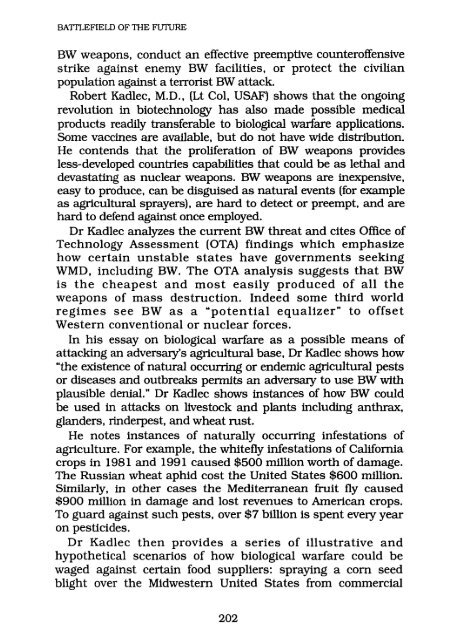BATTLEFIELD OF THE FUTURE
Battlefield of the Future - Air University Press
Battlefield of the Future - Air University Press
Create successful ePaper yourself
Turn your PDF publications into a flip-book with our unique Google optimized e-Paper software.
<strong>BATTLEFIELD</strong> <strong>OF</strong> <strong>THE</strong> <strong>FUTURE</strong><br />
BW weapons, conduct an effective preemptive counteroffensive<br />
strike against enemy BW facilities, or protect the civilian<br />
population against a terrorist BW attack .<br />
Robert Kadlec, M.D ., (Lt Col, USAF) shows that the ongoing<br />
revolution in biotechnology has also made possible medical<br />
products readily transferable to biological warfare applications .<br />
Some vaccines are available, but do not have wide distribution .<br />
He contends that the proliferation of BW weapons provides<br />
less-developed countries capabilities that could be as lethal and<br />
devastating as nuclear weapons . BW weapons are inexpensive,<br />
easy to produce, can be disguised as natural events (for example<br />
as agricultural sprayers), are hard to detect or preempt, and are<br />
hard to defend against once employed .<br />
Dr Kadlec analyzes the current BW threat and cites Office of<br />
Technology Assessment (OTA) findings which emphasize<br />
how certain unstable states have governments seeking<br />
WMD, including BW . The OTA analysis suggests that BW<br />
is the cheapest and most easily produced of all the<br />
weapons of mass destruction . Indeed some third world<br />
regimes see BW as a "potential equalizer" to offset<br />
Western conventional or nuclear forces .<br />
In his essay on biological warfare as a possible means of<br />
attacking an adversary's agricultural base, Dr Kadlec shows how<br />
"the existence of natural occurring or endemic agricultural pests<br />
or diseases and outbreaks permits an adversary to use BW with<br />
plausible denial ." Dr Kadlec shows instances of how BW could<br />
be used in attacks on livestock and plants including anthrax,<br />
glanders, rinderpest, and wheat rust .<br />
He notes instances of naturally occurring infestations of<br />
agriculture . For example, the whitefly infestations of California<br />
crops in 1981 and 1991 caused $500 million worth of damage .<br />
The Russian wheat aphid cost the United States $600 million .<br />
Similarly, in other cases the Mediterranean fruit fly caused<br />
$900 million in damage and lost revenues to American crops .<br />
To guard against such pests, over $7 billion is spent every year<br />
on pesticides .<br />
Dr Kadlec then provides a series of illustrative and<br />
hypothetical scenarios of how biological warfare could be<br />
waged against certain food suppliers : spraying a corn seed<br />
blight over the Midwestern United States from commercial<br />
202

















